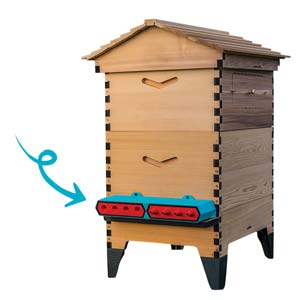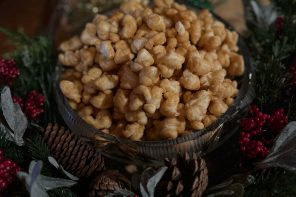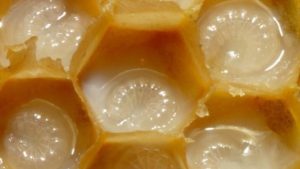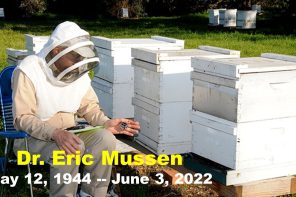Bee Vectoring with the Protectabee™
By: Erica Shelley , Tasmin Brown, Aparna Karthikeyan, Nicole Gauvreau, and Peter Kevan
They say that necessity is the mother of invention. In the pursuit of developing new technology that would enable bees to carry potentially beneficial fungal powders into their hives, we created an entirely new product that addresses several problems in modern beekeeping.
The original goal of the joint research project between Best for Bees and Dr. Peter Kevan’s team at the University of Guelph was to demonstrate that bees could carry powders into a beehive. Apivectoring, also known as bee vectoring, was pioneered by Dr. Kevan and associates 20 years ago. Pest and disease-fighting fungal powders coat honey bees or bumblebees as they exit the hive. The bees then deliver the fungus to the targeted crops’ flowers during regular pollination visits. Bee vectoring is now being implemented successfully to combat pests and diseases of several types of crops.
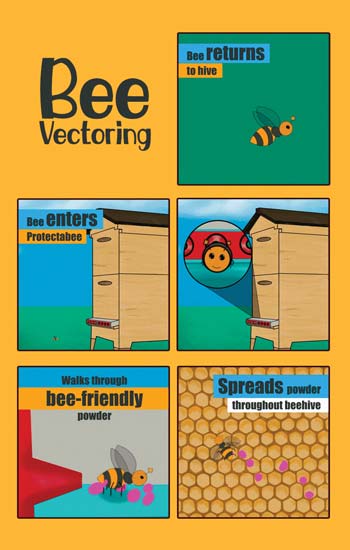
Figure 1
Bee vectoring (inspensing) illustration with the Protectabee outlines a bee returning from forage, walking through powder, and spreading powder throughout the hive.
Illusration by Cara Ward
Honey bees also struggle with many pests and diseases of their own, including Varroa mites, foulbrood diseases, and small hive beetle. Dr. Kevan recognized the potential of bee vectoring to combat threats within the hive. The process of moving powders into the colony, which his team coined inspensing (Fig. 1) (while outspensing refers to vectoring to crops), is complicated as bees are very efficient at cleaning out foreign materials. Creating a system that would outsmart the bees and effectively move powders within the hive proved challenging.
At the beginning of 2020, Dr. Kevan enlisted the services of a private research company, Best for Bees, to oversee research and development of the “inspenser.” Initial trials with a ramp-based prototype used in prior studies were less than satisfactory.
Since the two-year funded project depended on a successful device, Dr. Erica Shelley, founder and CEO of Best for Bees, recognized that an entirely new system was required. Borrowing from old-time bee escape boards using cones to direct bees away from honey supers, she realized that incorporating a separate entrance and exit at the front of the hive could be devised. However, the bees could easily bypass the powder by walking above it inside the device. After engineering many prototypes, she discovered a design that solved the problem and christened it the Protectabee.
The research team then set out to determine if the Protectabee would permit the bees to spread the powder throughout the hive efficiently. Bee transport of the powder was tracked via microscopic fluorescent beads in a carrier powder. In six hours or less, the bees emptied the powder from the drawer (Fig. 2). Using microscopy and UV light, the researchers determined that a minimum of 80% of the comb contained fluorescent powder (Fig. 3a).
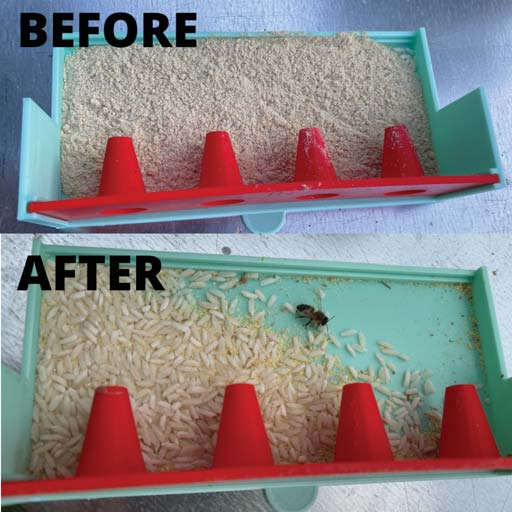
Figure 2
Before: 45ml of carrier powder + fungi (B. bassiana) added to drawer. After: 6 hours after adding the drawer to a beehive. Rice is used as a desiccant to keep powder dry.
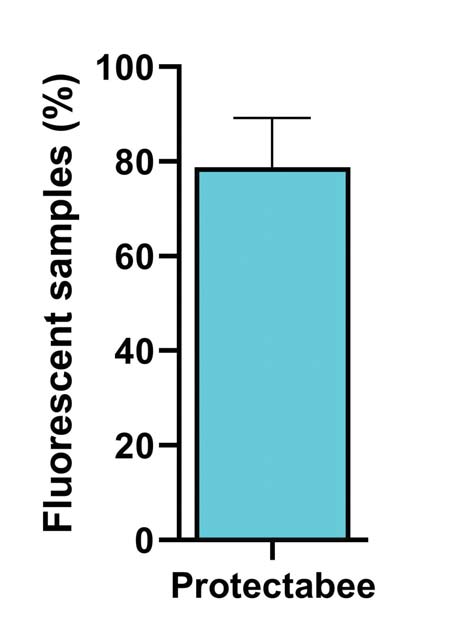
Figure 3a
Percentage of comb samples with fluorescence twenty-four hours after adding fluorescent microbeads and carrier powder to Protectabee drawer.
With proof of concept and a functioning device, the researchers set their sites onto vectoring antibiotics and fungi.
Antibiotics are used prophylactically to ward off American and European foulbrood before possible infection. Ontario’s recommended Spring application is to sprinkle the antibiotic/powdered sugar combination on top of the brood frames three times, two weeks apart, at least four weeks before the main honey flow. This timing can be tricky for beekeepers who live in cold or wet climates, not to mention labor-intensive.
As one of the wettest summers on record in Ontario, applying antibiotics inside the hives was a constant struggle. However, an advantage of the Protectabee is that the drawer can be pre-loaded before arriving at the apiary and simply slid into the device’s front without being impacted by adverse weather.
The research team determined that the Protectabee delivers dosages of antibiotics that correspond to concentrations of conventional applications (Fig. 3b). These findings are exciting as the Protectabee offers an entirely new and easy way to administer antibiotics efficiently into a hive.
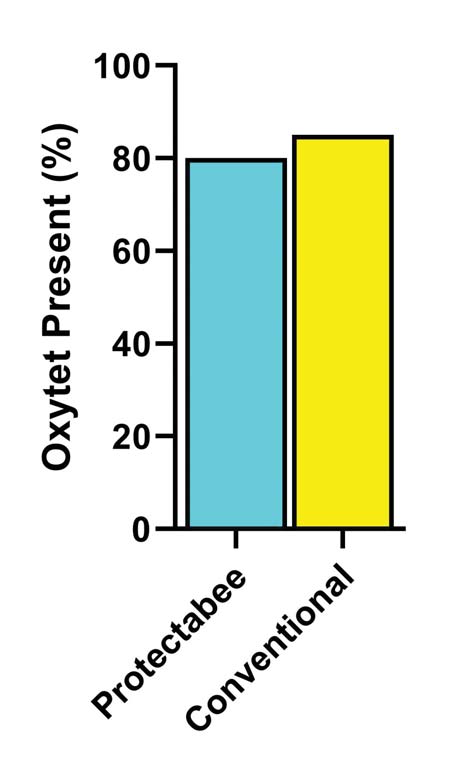
Figure 3b
Percentage of comb samples with oxytetracycline twenty-four hours after adding Oxytet and carrier powder to Protectabee drawer.
The biggest threat to bees in many parts of the world is the Varroa destructor mite. The mite feeds on young larvae, transmitting diseases that weaken the hive. Overtreatment has led to widespread resistance to conventional miticides. Developing an easy and effective mite control is one of the bigger goals of the Protectabee project. Possible candidates for mite control include fungi that act as parasites of insects. Beauveria bassiana and Metarhizium brunneum are two soil fungi that can infect Varroa mites.
Botanigard, a commercially available biological insecticide approved for bee vectoring in greenhouses in Canada, uses B. bassiana to protect strawberries against thrips, a problematic insect. Could the Protectabee effectively distribute Botanigard throughout a beehive, and would it decrease Varroa mites? Indeed, the fungus was successfully disseminated to about 50% of larvae using a single application of Botanigard with the Protectabee. Unfortunately, although mite drop increased immediately after application, Botanigard did not reduce Varroa mites long term when applied as a single dose (Fig. 4). These findings are not surprising as the warm and humid environment inside a beehive is not optimal for B. bassiana growth.
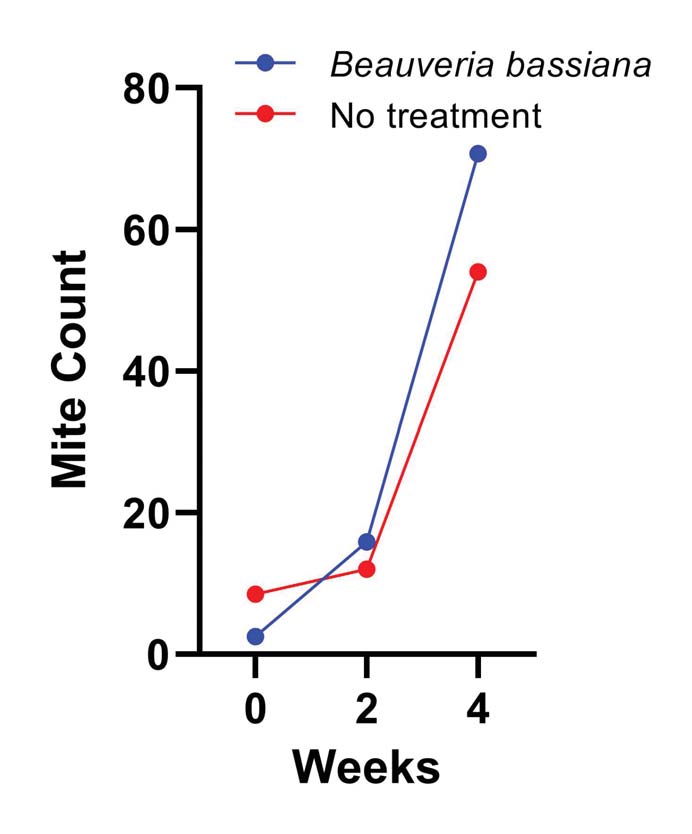
Figure 4
Average mite counts were determined before treatment using an alcohol wash (zero weeks) and at two weeks and four weeks post-treatment of Botanigard (B. bassiana) or no treatment (control).
Identifying a method for successfully introducing fungi into beehives using bee vectoring holds promise for the future. Researchers at Washington State University recently identified a variant of Metarhizium that effectively controls Varroa mites and is better suited for environmental conditions inside a hive (1). Once the Metarhizium strain has received approval, the fungi could combat mites employing the Protectabee and carrier powder as a delivery system. This combination could be an easy and effective method to improve honey bee health.
Bee vectoring offers an innovative method to introduce health improving powders into beehives with the additional benefits of reduced labor and heavy lifting, the ability to apply treatments in adverse weather conditions, and decreased hive disruption.
To learn more about Protectabee and ongoing research, visit our website at bestforbees.com. The Protectabee will be launching on Indiegogo in February 2022.
References
1. Han, J.O., Naeger, N.L., Hopkins, B.K. et al. Directed evolution of Metarhizium fungus improves its biocontrol efficacy against Varroa mites in honey bee colonies. Sci Rep 11, 10582 (2021). https://doi.org/10.1038/s41598-021-89811-2






